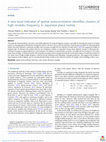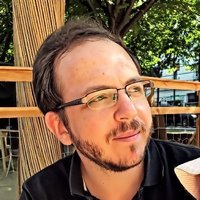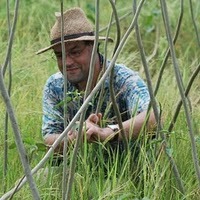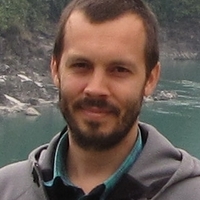Where to find my publications by Thomas Pellard
Papers by Thomas Pellard

Journal of Linguistic Geography
The methods of spatial statistics have been successfully applied to the study of linguistic varia... more The methods of spatial statistics have been successfully applied to the study of linguistic variation, especially for detecting the existence of spatial patterns in the geographical distribution of linguistic features. However, the use of local indicators of spatial autocorrelation for detecting spatial clusters have been limited to continuous variables, and we propose to apply the new method of Anselin and Li (2019) for categorical variables to linguistic data. We illustrate this method with the case of Japanese rendaku, or sequential voicing, whose dialectal variation is still poorly documented. Focusing on regional differences in the frequency of rendaku, we examined the occurrence of rendaku for four lexemes in 4,921 place names from all Japan. A statistical analysis of local spatial association and an unsupervised density-based cluster analysis revealed the existence of two cluster areas of high rendaku frequency centered around Wakayama and Fukushima-Yamagata prefectures. This...
HAL (Le Centre pour la Communication Scientifique Directe), Nov 20, 2021
HAL (Le Centre pour la Communication Scientifique Directe), Jul 7, 2021
HAL is a multidisciplinary open access archive for the deposit and dissemination of scientific re... more HAL is a multidisciplinary open access archive for the deposit and dissemination of scientific research documents, whether they are published or not. The documents may come from teaching and research institutions in France or abroad, or from public or private research centers. L'archive ouverte pluridisciplinaire HAL, est destinée au dépôt et à la diffusion de documents scientifiques de niveau recherche, publiés ou non, émanant des établissements d'enseignement et de recherche français ou étrangers, des laboratoires publics ou privés.
The rendaku morphophonological alternation between voiceless and voiced obstruents in compounds i... more The rendaku morphophonological alternation between voiceless and voiced obstruents in compounds is largely irregular, but it is observed in all Japanese dialects. However, whether dialectal differences in frequency of rendaku has received little attention hitherto. As a first step toward elucidating dialectal differences in the occurrence of rendaku, we examined the rendaku rate of six morphemes in place names from all Japan. The results of our exploratory study indicate that there is no clear geographical pattern in the differences in rendaku frequency, and that it varies between morphemes.

bioRxiv, 2022
Robbeets et al.'s "Triangulation supports agricultural spread of the Transeurasian languages" (Na... more Robbeets et al.'s "Triangulation supports agricultural spread of the Transeurasian languages" (Nature 599, 616-621, 2021) argue that the dispersal of the so-called "Transeurasian" languages, a highly disputed language superfamily comprising the Turkic, Mongolic, Tungusic, Koreanic, and Japonic language families, was driven by Neolithic farmers from the West Liao River region of China. They adduce evidence from linguistics, archaeology, and genetics to support their claim. An admirable feature of the Robbeets et al.'s paper is that all their datasets can be accessed. However, a closer investigation of all three types of evidence reveals fundamental problems with each of them. Robbeets et al.'s analysis of the linguistic data does not conform to the minimal standards required by traditional scholarship in historical linguistics and contradicts their own stated sound correspondence principles. A reanalysis of the genetic data finds that they do not conclusively support the farming-driven dispersal of Turkic, Mongolian, and Tungusic, nor the two-wave spread of farming to Korea. Their archaeological data contain little phylogenetic signal, and we failed to reproduce the results supporting their core hypotheses about migrations. Given the severe problems we identify in all three parts of the "triangulation" process, we conclude that there is neither conclusive evidence for a Transeurasian language family nor for associating the five different language families with the spread of Neolithic farmers from the West Liao River region.
Reports of the Keio Institute of Cultural and Linguistic Studies, 2019
琉球諸語と古代日本語:日琉祖語の再建に向けて, 2016

Bulletin de la Société de Linguistique de Paris, 2018
The commercially successful book by archaeologist Jean-Paul Demoule (Seuil, 2014) casts doubt on ... more The commercially successful book by archaeologist Jean-Paul Demoule (Seuil, 2014) casts doubt on the existence of an ancestral language of the Indo-European family on the ground of criticisms directed at Indo-European linguistics, and at historical linguistics in general. We show here that these criticisms are based on a biased documentation, and that they contain numerous errors and misinterpretations, of which we present a selection. We examine the potential alternatives to the idea of an ancestral language : pidginization, creolization, interactions within a Sprachbund, formation of mixed languages through prolonged mutual contact, and show that all fail to account for the verbal, nominal and pronominal inflections common to the various branches of the family. Finally, we reject the equation between Indo-European linguistics and racist ideologies. We reaffirm the scientific and non-ideological nature of Indo-European historical linguistics.
tudies in Japanese and Korean historical and theoretical linguistics and beyond, 2017
Perspectives on morphological organization: Data and analyses, 2017
Kibe, Nobuko. 消滅危機方言の調査・保存のための総合的研究:八丈方言調査報告書 Shōmetsu kiki hōgen no chōsa/hozon no tame no sōgōteki kenkyū: Hachijō hōgen chōsa hōkokusho [General research for the study and conservation of endangered dialects in Japan: Survey report on the Hachijō dialect], NINJAL, pp.47−67., 2013
Full text (PDF): http://pj.ninjal.ac.jp/endangered/Research%20Report%20on%20Hachijo.pdf
Full text (PDF): https://hal.archives-ouvertes.fr/hal-01356834v3
In recent work on Japanese phono... more Full text (PDF): https://hal.archives-ouvertes.fr/hal-01356834v3
In recent work on Japanese phonology, /r/ has been argued to be a unique consonant in the Japanese phonological system, characterized by its default, unmarked and featureless nature. These peculiar features have been claimed to derive from the original epenthetic status and the late historical phonologization of /r/ in Japanese. However, a review of all the relevant evidence shows that there is actually no solid basis for that hypothesis, which proves to be not only inadequate, but also directly falsified by the data. No r-epenthesis process can be reconstructed in earlier Japanese, and /r/ cannot be analyzed as a unique, default, empty consonant.
Full text (PDF): https://hal.archives-ouvertes.fr/hal-01289268
Handbook of the Ryukyuan languages, 2015
Full text (PDF): https://hal.archives-ouvertes.fr/hal-01289257











Uploads
Where to find my publications by Thomas Pellard
https://cv.archives-ouvertes.fr/thomas-pellard.
Thank you for your interest in my work. You can find a full list of my publications and freely download them at:
https://cv.archives-ouvertes.fr/thomas-pellard.
私の研究に興味をもってくださり,ありがとうございます。
https://cv.archives-ouvertes.fr/thomas-pellardにて研究論文・資料を自由にダウロンロードできます。
Papers by Thomas Pellard
In recent work on Japanese phonology, /r/ has been argued to be a unique consonant in the Japanese phonological system, characterized by its default, unmarked and featureless nature. These peculiar features have been claimed to derive from the original epenthetic status and the late historical phonologization of /r/ in Japanese. However, a review of all the relevant evidence shows that there is actually no solid basis for that hypothesis, which proves to be not only inadequate, but also directly falsified by the data. No r-epenthesis process can be reconstructed in earlier Japanese, and /r/ cannot be analyzed as a unique, default, empty consonant.
https://cv.archives-ouvertes.fr/thomas-pellard.
Thank you for your interest in my work. You can find a full list of my publications and freely download them at:
https://cv.archives-ouvertes.fr/thomas-pellard.
私の研究に興味をもってくださり,ありがとうございます。
https://cv.archives-ouvertes.fr/thomas-pellardにて研究論文・資料を自由にダウロンロードできます。
In recent work on Japanese phonology, /r/ has been argued to be a unique consonant in the Japanese phonological system, characterized by its default, unmarked and featureless nature. These peculiar features have been claimed to derive from the original epenthetic status and the late historical phonologization of /r/ in Japanese. However, a review of all the relevant evidence shows that there is actually no solid basis for that hypothesis, which proves to be not only inadequate, but also directly falsified by the data. No r-epenthesis process can be reconstructed in earlier Japanese, and /r/ cannot be analyzed as a unique, default, empty consonant.
The native Japanese name of the Buddha hotoke < poto2ke2 has no internal etymology and is likely to be a loanword introduced together with Buddhism. The hypothesis of a link with Korean pwuche < pwuthye ‘Buddha’ and of their ultimate origin as deriving from a Chinese rendering of Sanskrit Buddha makes sense from both a linguistic and historical point of view. Still, the last part of the Japanese and Korean forms has no correspondent in Chinese and has remained unaccounted for hitherto. From the comparison with the pattern ‘Buddha-lord’ for the name of Buddha in several Asian languages, it is hypothesized that the enigmatic final element was originally a word for ‘lord, ruler, king’. This hypothesis is confirmed by the attestation of such a word in toponyms and in nobility titles recorded in ancient Chinese, Korean, and Japanese chronicles.
1. Test the accuracy and coverage of the analysis of the morphology.
2. Partially automate the glossing of texts.
3. Enable quantitative measures of morphological complexity.